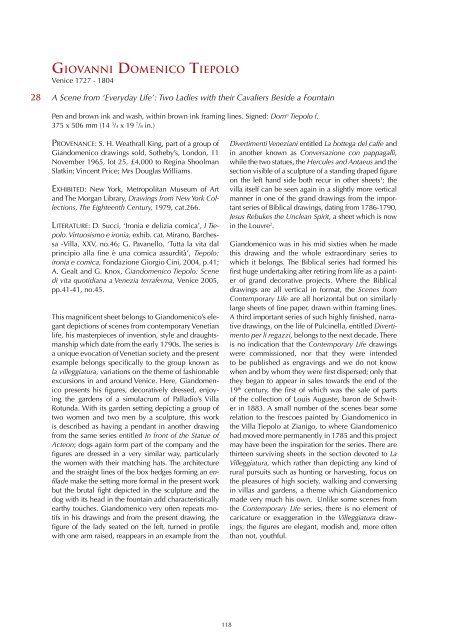You also want an ePaper? Increase the reach of your titles
YUMPU automatically turns print PDFs into web optimized ePapers that Google loves.
Giovanni Domenico Tiepolo<br />
Venice 1727 - 1804<br />
28<br />
A Scene from ‘Everyday Life’: Two Ladies with their Cavaliers Beside a Fountain<br />
Pen and brown ink and wash, within brown ink framing lines. Signed: Dom o Tiepolo f.<br />
375 x 506 mm (14 3 /4 x 19 7 /8 in.)<br />
Provenance: S. H. Weathrall King, part of a group of<br />
Giandomenico drawings sold, Sotheby’s, London, 11<br />
November 1965, lot 25, £4,000 to Regina Shoolman<br />
Slatkin; Vincent Price; Mrs Douglas Williams.<br />
Exhibited: New York, Metropolitan Museum of Art<br />
and The Morgan Library, <strong>Drawings</strong> from New York Collections,<br />
The Eighteenth Century, 1979, cat.266.<br />
Literature: D. Succi, ‘Ironia e delizia comica’, I Tiepolo.<br />
Virtuosismo e ironia, exhib. cat. Mirano, Barchessa<br />
-Villa, XXV, no.46; G. Pavanello, ‘Tutta la vita dal<br />
principio alla fine è una comica assurdità’, Tiepolo:<br />
ironia e comica, Fondazione Giorgio Cini, 2004, p.41;<br />
A. Gealt and G. Knox, Giandomenico Tiepolo: Scene<br />
di vita quotidiana a Venezia terraferma, Venice 2005,<br />
pp.41-41, no.45.<br />
This magnificent sheet belongs to Giandomenico’s elegant<br />
depictions of scenes from contemporary Venetian<br />
life, his masterpieces of invention, style and draughtsmanship<br />
which date from the early 1790s. The series is<br />
a unique evocation of Venetian society and the present<br />
example belongs specifically to the group known as<br />
la villeggiatura, variations on the theme of fashionable<br />
excursions in and around Venice. Here, Giandomenico<br />
presents his figures, decoratively dressed, enjoying<br />
the gardens of a simulacrum of Palladio’s Villa<br />
Rotunda. With its garden setting depicting a group of<br />
two women and two men by a sculpture, this work<br />
is described as having a pendant in another drawing<br />
from the same series entitled In front of the Statue of<br />
Acteon; dogs again form part of the company and the<br />
figures are dressed in a very similar way, particularly<br />
the women with their matching hats. The architecture<br />
and the straight lines of the box hedges forming an enfilade<br />
make the setting more formal in the present work<br />
but the brutal fight depicted in the sculpture and the<br />
dog with its head in the fountain add characteristically<br />
earthy touches. Giandomenico very often repeats motifs<br />
in his drawings and from the present drawing, the<br />
figure of the lady seated on the left, turned in profile<br />
with one arm raised, reappears in an example from the<br />
Divertimenti Veneziani entitled La bottega del caffe and<br />
in another known as Conversazione con pappagalli,<br />
while the two statues, the Hercules and Antaeus and the<br />
section visible of a sculpture of a standing draped figure<br />
on the left hand side both recur in other sheets 1 ; the<br />
villa itself can be seen again in a slightly more vertical<br />
manner in one of the grand drawings from the important<br />
series of Biblical drawings, dating from 1786-1790,<br />
Jesus Rebukes the Unclean Spirit, a sheet which is now<br />
in the Louvre 2 .<br />
Giandomenico was in his mid sixties when he made<br />
this drawing and the whole extraordinary series to<br />
which it belongs. The Biblical series had formed his<br />
first huge undertaking after retiring from life as a painter<br />
of grand decorative projects. Where the Biblical<br />
drawings are all vertical in format, the Scenes from<br />
Contemporary Life are all horizontal but on similarly<br />
large sheets of fine paper, drawn within framing lines.<br />
A third important series of such highly finished, narrative<br />
drawings, on the life of Pulcinella, entitled Divertimento<br />
per li regazzi, belongs to the next decade. There<br />
is no indication that the Contemporary Life drawings<br />
were commissioned, nor that they were intended<br />
to be published as engravings and we do not know<br />
when and by whom they were first dispersed; only that<br />
they began to appear in sales towards the end of the<br />
19 th century, the first of which was the sale of parts<br />
of the collection of Louis Auguste, baron de Schwiter<br />
in 1883. A small number of the scenes bear some<br />
relation to the frescoes painted by Giandomenico in<br />
the Villa Tiepolo at Zianigo, to where Giandomenico<br />
had moved more permanently in 1785 and this project<br />
may have been the inspiration for the series. There are<br />
thirteen surviving sheets in the section devoted to La<br />
Villeggiatura, which rather than depicting any kind of<br />
rural pursuits such as hunting or harvesting, focus on<br />
the pleasures of high society, walking and conversing<br />
in villas and gardens, a theme which Giandomenico<br />
made very much his own. Unlike some scenes from<br />
the Contemporary Life series, there is no element of<br />
caricature or exaggeration in the Villeggiatura drawings,<br />
the figures are elegant, modish and, more often<br />
than not, youthful.<br />
118
















